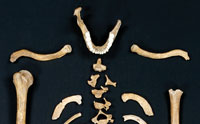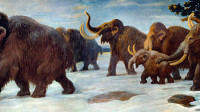By Ken Ham Surely I don’t need to say anything more about this video clip and a claim that “these walking fish raised out of water on land help explain evolution” than quote this verse: Professing to be wise, they became fools. (Romans 1:22) You can watch the video clip and read an article about these fish at this link. Thanks for stopping by and thanks for praying, Ken …read more Read more here: Ken Ham AIG
Even if you don’t yet know any other compelling evidences that the Bible is true, you should know the experience of your own life. …read more Read more here: AIG Daily
Cosmos: A SpaceTime Odyssey host wonders why Answers in Genesis critiqued his series and why anyone cares. …read more Read more here: AIG Daily
By Ken Ham Because the human race has been in a spiritual battle for 6,000 years (since Genesis 3), the Bible uses a lot of battle imagery concerning spiritual warfare. For instance, we read this in the book of Ephesians: Therefore take up the whole armor of God, that you may be able to withstand in the evil day, and having done all, to stand. Stand therefore, having girded your waist with truth, having put on the breastplate of righteousness, and having shod your feet with the preparation of the gospel of peace; above all, taking the shield of faith [More]
Click here to listen. On this episode of ID the Future, hear Casey Luskin’s interview with Issues, Etc., in which he responds to false claims that intelligent design theory is based on religious belief. Casey discusses how many Darwin doubters have found the scientific evidence for Darwinian evolution to be greatly lacking, despite claims of a “scientific consensus” on evolution.
By Creation Moments Scripture frequently makes reference to the fact that birds are not very smart compared to human beings. The tropical wetland bird called the jacana shows that you don’t have to be very smart to be deceptive. The jacana is noteworthy for several reasons. It is one of only 20 species of birds in the world where the female leaves the care of the young to the males. read more …read more Read more here: Creation Moments
As a well-known US street evangelist constantly encounters the challenge of evolutionary thinking, he is well-equipped with the answers. …read more Read more here: creation.com
By Ken Ham Over two weeks ago, I wrote a blog post about a Creation Museum digital billboard that was placed in Washington, DC. As you know, the nation’s capital features one of the leading atheistic evolutionary museums in the world: the Smithsonian Natural History Museum. Because millions of people visit Washington, DC, each year, we decided to reach out to this influential city and let people know about a museum where they can learn the truth concerning origins, God’s Word, and the gospel—the Creation Museum. We also wanted people to know that this year, kids twelve and under can [More]
The case for Neandertals as more primitive members of an evolutionary continuum that spans from apes to modern man continues to weaken. Genetic and archaeological finds are completely reshaping modern concepts of Neandertal men and women. More… …read more Read more here: icr.org
By Creation Moments How do you take a much needed nap or get a good night’s sleep when you must be alert to danger? Human beings designate people to stay awake and watch for danger when they sleep. Then, they set up warning systems. read more …read more Read more here: Creation Moments
The “superorganism” that you are testifies to the superlative wisdom of our Creator God. …read more Read more here: AIG Daily
Zonkeys attest to the variations possible within the “horse kind.” …read more Read more here: AIG Daily
Arthropods moult in mere minutes, yet this ancient specimen was caught in the act, showing disaster struck suddenly, like the Bible says. …read more Read more here: creation.com
By Creation Moments Sometimes it seems as if God made some creatures just to show us He could do the impossible. Many of these creatures, by their strange nature, offer direct challenges to evolutionary theory, since there was no evolutionary need for their unique nature. read more …read more Read more here: Creation Moments
The battle of world views is often most fiercely contested when it concerns the believed age of rocks. Northern Ireland’s Giant’s Causeway illustrates this particularly well. …read more Read more here: creation.com
By Ken Ham Creation Museum member Bob Worstell shared something interesting with us recently. About 55 years ago, he subscribed to the magazine Popular Science but soon stopped. A few weeks ago, Bob thought he would subscribe again to Popular Science, and he received a trial issue. The first copy he got in the mail, 55 years later, was one with Bill Nye “the Science Guy” on the cover. In a long—and sometimes combative—article (note the cover’s depiction), Nye discussed his debate with me last February. The debate became something of a national event, with a conservatively estimated 15 million [More]
Circular Reasoning in the Dating of Deep Seafloor Sediments and Ice Cores: The Orbital Tuning Method
The different dating systems are calibrated to one another: dates assigned to the seafloor sediments are used to date the ice cores, and vice versa. …read more Read more here: AIG Daily
By Creation Moments Has your great great-grandfather been born yet? If he hasn’t, he’s not your great great-grandfather! This might seem like a silly question. But when it comes to the claimed evolutionary fossil evidence for man’s evolution, our claimed great great-grandfather has turned up in the wrong period of history. read more …read more Read more here: Creation Moments
God has vindicated His Word, and His Book is a genuine writing, with prophecies and revelation that must be taken seriously. …read more Read more here: AIG Daily
Click here to listen. On this episode of ID the Future, Casey Luskin addresses the question: Is intelligent design science? While the precise definition of “science” has long been debated, most would agree that there are certain qualities that clearly define some ideas as science. Luskin examines the theory of intelligent design by this criteria, showing how ID uses the scientific method, undergoes peer review, and does not require non-natural causes.
An octopus can change the color of its skin at will to mimic any kind of surrounding. It actively camouflages itself with astoundingly complicated biological machinery. Wouldn’t it be great if, say, a soldier’s uniform or an armored vehicle used similar technology? More… …read more Read more here: icr.org
By Creation Moments Dung beetles may not be a very pleasant subject, but after all, someone has to do the housekeeping. So God created what man has classified into 30,000 species of dung beetle. Many will form their finds into a ball about the size of a croquet ball and roll it home for the wife and kids. Others tunnel beneath a find and set up housekeeping there. read more …read more Read more here: Creation Moments
Natural Trap Cave preserves a treasure trove of animals from the Ice Age until the 1970s. …read more Read more here: AIG Daily
According to New Scientist, we are losing our religion. But there’s more to the story than they’re willing to admit. …read more Read more here: creation.com
Popular Science‘s September 2014 issue has jumped into an arena that it is unprepared for, and this particular issue should be renamed Popular Spin magazine. …read more Read more here: AIG Daily
By Creation Moments Did King David go to the mall? Malls or shopping areas are hugely popular today. Archaeologists are now asking whether shopping malls originated in the 11th century BC. read more …read more Read more here: Creation Moments
Secular scientists claimed in the 1970s that chimp genomes are 98% similar to humans, and it was apparently verified by more modern techniques. But that estimate actually used isolated segments of DNA that we already share with chimps—not the whole genomes. The latest comparison that included all of the two species’ DNA revealed a huge difference from the percentage scientists have been claiming for years. More… …read more Read more here: icr.org







































